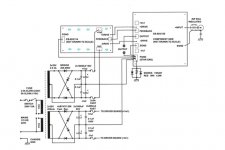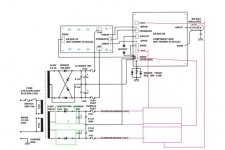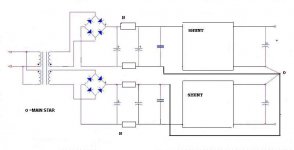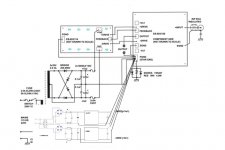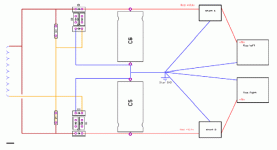RCruz said:I really like this hands on aproach...I keep learning that way.
Below is the present GND layout.
Now I have a superlative Phono replay system.
Ricardo
Nice clean drawing. Very informative for those to build in the future.
So as the master tweaker of this thread
 , you recommend up to now, a heavy toroid (how many VA is yours?), 2 fast bridges (what you use?) 2 shunts, wiring as in the posted zip, for guaranteed non hum infested, expertly voiced sound reproduction. Parts choices as shown in the most recent picure I guess.
, you recommend up to now, a heavy toroid (how many VA is yours?), 2 fast bridges (what you use?) 2 shunts, wiring as in the posted zip, for guaranteed non hum infested, expertly voiced sound reproduction. Parts choices as shown in the most recent picure I guess.nicoch46 said:humm,as I dont use heart and separate dual mono ,is ok??
PS Salas shunt for amp drive stage
Depends on how the rest of your amp will be grounded.
I would connect the filter gnds as shown from EB, then only +/- to shunts, then one ground wire from pos, and another ground wire from neg shunt to central star.
nicoch46 said:like this ?
as I have 2bridge
Like this:
Attachments
0=main star is on psu or on drive pcb star ?
ie:
I can run four gnd wire on pcb drive star
I can run two gnd , one for halve
or single .....
ie:
I can run four gnd wire on pcb drive star
I can run two gnd , one for halve
or single .....
Salas said:
Nice clean drawing. Very informative for those to build in the future.
So as the master tweaker of this thread, you recommend up to now, a heavy toroid (how many VA is yours?), 2 fast bridges (what you use?) 2 shunts, wiring as in the posted zip, for guaranteed non hum infested, expertly voiced sound reproduction. Parts choices as shown in the most recent picure I guess.
Thank you so much for the kind words 🙂
I am using a 80VA Toroid encapsulated 2 x 15v.
Manufacturer Nuvotem
Manufacturers Part No. 0080P1-2-015K
For the bridges I use Hexfred HFA08TB60PBF, Ultra fast / Soft Recovery 8A (Almost as detailed as a shottky but without the edge).
After that I have one 10.000uF 63V BHC to feed each shunt.
Do not forget the BGNx after the shunts, use teflon FT-3 between stages in the Riaa and silver mica or good film foil in the eq circuit. (I would avoid PIO caps there).
Fundamental: use shinkoh for cart loading.
decoupling caps in the Riaa are 220uF Ruby ZA 35v.... quite fast and very neutral.
This circuit sounds so good it deserves the best output caps !!! (I love the obbligato...
 )
)Ricardo
Hi,RCruz said:Below is the present GND layout.
Now I have a superlative Phono replay system.
join C5 & C6 zero volt pins/screws.
Run one wire from zero volts to star ground.
Measure hum and buzz and noise before and after this modification and let us know if there is any change.
YYEESS !!
It keeps the pulsing currents in the two charging loops separate from the voltage reference.
It keeps the pulsing currents in the two charging loops separate from the voltage reference.
AndrewT said:
Hi,
join C5 & C6 zero volt pins/screws.
Run one wire from zero volts to star ground.
Measure hum and buzz and noise before and after this modification and let us know if there is any change.
Salas said:Long tail common return, to avoid star contamination, D. Self style?
Gentlemen
All morning I have been rewiring the GND because I still noticed some hum with yesterday mods.
I decided to connect the second cap GND to the first one and than run to star..... this reduced a lot the noise so I decided to post the revision.
I was tottaly surprised when I saw your comments.... Your suggestion is exactly what I did. It works wonderfully.
It looks like a worldwide brainstorm

Ricardo
I believe you, It's just a pity that you did it before taking those measurements. Your ears seem to have told you the story you needed to hear.
I do not know how to measure noise in the ve lines so I depend on my ears. Maybe you use a scope for that purpose ?!
I am glad I found the solution but I only used common sence (reduce gnd loops visually) and hearing the results while taping a 10r+wire from the second cap GND to several other GND locations... The worst was connecting it directly to the star and surprinsingly, it disappeared when I connected the other end of the wire to the 1st cap GND.
Thanks to you I now understand why it works. 😉
It is better then ever but I would like to totally eliminate the shunt working low level noise.... Should I improve the smoothing circuit or should I dedicate my attention to the lines between the TX and the rectifiers ? (I saw nicoch46 sketch where there is some kind of RC circuit before the bridge).
Ricardo
I am glad I found the solution but I only used common sence (reduce gnd loops visually) and hearing the results while taping a 10r+wire from the second cap GND to several other GND locations... The worst was connecting it directly to the star and surprinsingly, it disappeared when I connected the other end of the wire to the 1st cap GND.
Thanks to you I now understand why it works. 😉
It is better then ever but I would like to totally eliminate the shunt working low level noise.... Should I improve the smoothing circuit or should I dedicate my attention to the lines between the TX and the rectifiers ? (I saw nicoch46 sketch where there is some kind of RC circuit before the bridge).
Ricardo
put 0.1 X2 caps on secondary ,
tray rfi filter on main
coil are better than a resistor, but...there is a shunt....
EI or r-core trafo filter a lot better the main 230v
what shottky use before ?
tray rfi filter on main
coil are better than a resistor, but...there is a shunt....
EI or r-core trafo filter a lot better the main 230v
what shottky use before ?
So your indications are related with rfi filtering....
I used 11DQ09 or 11DQ10 shotkys. These make a real difference in detail retrieval.
I believe I do not have rfi contamination unless I turn on the CDP at the same time I am listening to the TT (Almost never happens 😀 )
What I would like to do is to remove the PA sound the riaa makes when idling at more than half the volume. (When I play a record, the noise is buried beneath the vinyl surface noise, but it is present and so I would like to remove it completely).
Ricardo
I used 11DQ09 or 11DQ10 shotkys. These make a real difference in detail retrieval.
I believe I do not have rfi contamination unless I turn on the CDP at the same time I am listening to the TT (Almost never happens 😀 )
What I would like to do is to remove the PA sound the riaa makes when idling at more than half the volume. (When I play a record, the noise is buried beneath the vinyl surface noise, but it is present and so I would like to remove it completely).
Ricardo
- Home
- Source & Line
- Analogue Source
- Simplistic NJFET RIAA
